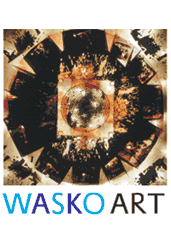Frequently Asked Questions
What are Labyrinths?
 Of mysterious origins, the first labyrinth, according to labyrinth expert Hermann Kern* may have been a dance whose steps were later recorded. The oldest ones are found on Syrian pottery fragments and on clay tablets from Pylos, Greece around 1200 B.C. A labyrinth, in a tomb in Luzzana, Italy is thought to be 2300 BC.
Of mysterious origins, the first labyrinth, according to labyrinth expert Hermann Kern* may have been a dance whose steps were later recorded. The oldest ones are found on Syrian pottery fragments and on clay tablets from Pylos, Greece around 1200 B.C. A labyrinth, in a tomb in Luzzana, Italy is thought to be 2300 BC.
Labyrinths find their way into almost every country in the world: Greece, Egypt, India, Peru, Iceland, Europe, and the American Southwest, to name a few. A Tohono O’odham basket from southern Arizona has a Man in the Maze design. The Hopi Indians have two forms: a spiral sun father, and a square mother earth with unborn child.
Three major patterns are the Classic 7-circuit, believed to be the oldest; the Concentric, formed from the meander pattern, and the Chartres Design, seen on the floor of that Medieval cathedral near Paris. The labyrinth design combines the circle and the spiral form found throughout the universe from the galaxies to our DNA, and which is a symbol for wholeness, unity, and transformation. In most cultures labyrinths celebrate life’s major events: birthdays, weddings and funerals, the cycles: birth, death, and rebirth.
 Classical Labyrinth |
 Concentric Labyrinth |
 Chartres Labyrinth |
Today labyrinths are found in parks and prisons, churches and retreat centers, schools and playgrounds. Lying dormant for centuries, they are undergoing a revival for meditation, dance, rituals, decision making, problem solving, and just plain fun. Children love them, and researchers speak of their benefits for those with such diseases as dyslexia, Parkinson’s and Alzheimer’s.
In 1998, as a founding member of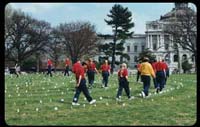 The Labyrinth Society, Sandra Wasko-Flood directed its traveling exhibit, “Labyrinths for Peace: 2000” first shown the Cannon Rotunda of the House of Representatives, which included labyrinth walking on the east lawn of the U.S.Capitol. At the turn of the millennium, labyrinths are an apt symbol for peace within oneself, one’s communities, and the world.
The Labyrinth Society, Sandra Wasko-Flood directed its traveling exhibit, “Labyrinths for Peace: 2000” first shown the Cannon Rotunda of the House of Representatives, which included labyrinth walking on the east lawn of the U.S.Capitol. At the turn of the millennium, labyrinths are an apt symbol for peace within oneself, one’s communities, and the world.
* Kern, Hermann, Through the Labyrinth: Designs and Meanings over 5000 Years, Prestel, 2000
What is "Dance of the Labyrinth"?
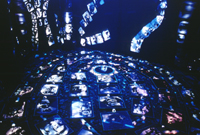 “Dance of the Labyrinth” as “an interactive labyrinth installation under glass which is designed to be walked. The path is made up of large photo transparencies in glass boxes surrounded by computer programmed lighting and wall hangings. The design is based on a combination of the spiral and the seven-circuit path. The visitor walks on pressure-sensitive glass towards a central mirror ( where they see their own face) and to a mirror ball. The path contains composite images of icons, people mummies and animals, superimposed to show the ‘single reality of existence.’ The idea according to Wasko-Flood is to ‘dance with opposites.’ Her aim is to offer her audience a ‘multi-sensory journey uniting art and life, darkness and light.”*
“Dance of the Labyrinth” as “an interactive labyrinth installation under glass which is designed to be walked. The path is made up of large photo transparencies in glass boxes surrounded by computer programmed lighting and wall hangings. The design is based on a combination of the spiral and the seven-circuit path. The visitor walks on pressure-sensitive glass towards a central mirror ( where they see their own face) and to a mirror ball. The path contains composite images of icons, people mummies and animals, superimposed to show the ‘single reality of existence.’ The idea according to Wasko-Flood is to ‘dance with opposites.’ Her aim is to offer her audience a ‘multi-sensory journey uniting art and life, darkness and light.”*
First shown in 1994 at Gallery 10 in Washington DC, the large installation (18′ x 15′ x 10’) received a grant from the Virginia Commission on the Arts in the same year. Now located in the artist’s studio in NW DC, it is open to visitors by appointment. The artist attributes her inspiration first to a trip to Russia in 1990 where she envisioned the icons leaving the walls and ceilings of cathedrals and coming from the earth, where to walk on icons would not be irreverent but sacred. Next she recalls a vision at the Great Kiva, or Indian ceremonial center in Chaco Canyon, New Mexico, of the Anazazi Indians dancing through the circular wall in a labyrinth motion inviting her to their step.
In this sacred marriage for all times, she invites us to dance with opposites: opposite images, and those opposites in ourselves–to meet characters from previous series: the “Brazilian” macumba (Afro-Christian religious) dancers, strange animal “Totems”– monkeys, birds, and snakes–and even stranger “Goddesses” icons merged with mummies and animals. As one follows the earth, water, fire, and air paths, the phosphorescent painted mulch glows like moonlight, and the colored Japanese papers shine like stained glass. As pillars rotate, the mirror ball turns and the surrounding figures dance, she invites us to “Cycles” of transformation. To confront oneself in the mirror at center. Is the image is real? Or a reflection? A passage to another world? Life, death, or rebirth?
*Westbury, Virginia, Labyrinths: Ancient Paths of Wisdom and Peace, Landsdowne Publishing Pty Ltd, Sydney NSW 2001 Australia, page 94 [http://www.paragate.org/Labyrinth/Westbury.html]
“Dance of the Labyrinth”
Unloose the snake
From round your neck.
Unloose the snake
That stores the fire
Of the Labyrinth
From Under
Thunder.
Unloose the snake
From round your neck.
The One who Partakes
Of Bird and Fish and Worm,
The One Scripted
To Exist
In Wonder.
Unloose the snake
From round your neck.
One step forward,
One step back.
One step future,
One step past,
Near the Center,
Near the Edge.
Miss not a step.
Miss not the abyss.
Dance with flames.
Dance with shades.
Grasp the throat.
Release the others.
Slide to Center.
Hiss a Kiss.
-Sandra Wasko-Flood 1992
What are "Elements to Light Your Way"?
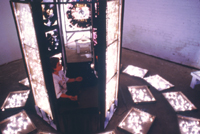
In “Elements to Light Your Way,” (20″ x 20″ x 6′) the participant walks on a light glass spiral which leads to a central octagon shaped enclosure. Facing him within the “meditation center” he views four “Pillars of Light” and sees four surrounding “Wheels of Light” which represent the elements of earth, air, fire, and water.
“Reflected Elements” contains an octagon center with sixteen 8′ x 2′ mirrors and four pillars of light. The visitor is invited to “reflect” on his life as his image repeats and 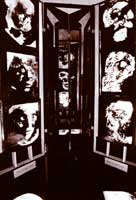 merges many times with those in the pillars. He may also turn the surrounding “Wheels of Light” as the photo images with Japanese papers superimpose through chaos and order, darkness and light.
merges many times with those in the pillars. He may also turn the surrounding “Wheels of Light” as the photo images with Japanese papers superimpose through chaos and order, darkness and light.
What is Kinetic Photo Sculpture?
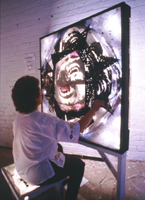 Designed in series of four, they can be viewed as individual pieces or part of larger installations. The participant turns the “Wheels of Light,” installed in glass boxes 4′ x 4′, through journeys of earth, air, fire, and water. Transparent photo images, of icons and mummies, people and animals, superimpose through the layers of plexiglass and mirrors as if chaos becomes order, and the darkness, light.
Designed in series of four, they can be viewed as individual pieces or part of larger installations. The participant turns the “Wheels of Light,” installed in glass boxes 4′ x 4′, through journeys of earth, air, fire, and water. Transparent photo images, of icons and mummies, people and animals, superimpose through the layers of plexiglass and mirrors as if chaos becomes order, and the darkness, light.
The rotating “Pillars of Light,” two floor and two ceiling pieces, are 4′ high backlit motor run sculptures. Each contains three triangular pyramids with photo image turning through the cycles: “Birth into Death,” “Death into Birth,”” Birth into Rebirth,” “Rebirth into Rebirth.”
The smaller “Light Boxes” ( 21″ x 17″ x 4″) wall pieces suggest movement from the patterns the metal gratings make on the walls. They duplicate the images in “Dance of the Labyrinth” and are available as cibachrone photos.
What is “Rainbow Labyrinth of Peace”?
What are Wall Light Boxes?
What is Living Labyrinths for Peace?
What is the artist’s new book
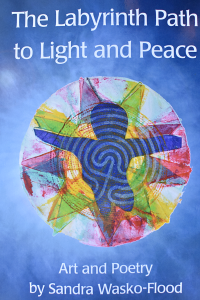
The Labyrinth Path to Light and Peace
Art and Poetry by Sandra Wasko Flood
Sandra’s new book will lead you on a contemplative journey. Come savor the delight of these words and sacred archetypal images. Hers is the kind of art that invites you to walk into that picture, walk into that labyrinth. This is the promise of higher intelligence uniting with the spirit of a compassionate heart.
For more information, see LabyrinthPath.com
Goals
The Dream
Sandra Wasko-Flood’s dream is to establish “Dance of the Labyrinth” as a permanent center for meditation and creativity, research and education. She wishes the center to be located in a place easily accessible to people of many different races, ages, classes; and cultures; and to be open for visits, workshops, performances and other events. She envisions the relationship between art and technology to be ongoing and changing, for the technology to be constantly refined to enhance the beauty of the art, and the art to increase the perception of the labyrinth archetype. She hope to broaden and deepen what most claim to be their experience when walking the labyrinth: its peace, power, and mystery.
Specifically, she sees the construction of a round glass structure with three rooms open to the earth and the stars, as originally presented in 1994 at Gallery 10 in Washington DC. “Under Earth,” “On Earth,” and “Above Earth” would be accessible by elevator so one could see lights and images above and below.
Because of its layered construction, both literally and symbolically, this participatory art piece can literally relate to every subject, as well as one’s entire being: physical, psychological and spiritual. Workshops in the arts–visual, music, dance– technology, sciences, social sciences, religion and spirituality could easily take place. Questions from specific disciplines, such as the effects of light sequences on one’s mood or personality, the designs of computers to program the lights, could be researched. People could walk for meditation and creativity: to make decisions and solve problems, create new art forms and celebrate life’s major events.
Sandra Wasko-Flood’s dream is to establish “Dance of the Labyrinth” as a permanent center for meditation and creativity, research and education. She wishes the center to be located in a place easily accessible to people of many different races, ages, classes; and cultures; and to be open for visits, workshops, performances and other events. She envisions the relationship between art and technology to be ongoing and changing, for the technology to be constantly refined to enhance the beauty of the art, and the art to increase the perception of the labyrinth archetype. She hope to broaden and deepen what most claim to be their experience when walking the labyrinth: its peace, power, and mystery.
Specifically, she sees the construction of a round glass structure with three rooms open to the earth and the stars, as originally presented in 1994 at Gallery 10 in Washington DC. “Under Earth,” “On Earth,” and “Above Earth” would be accessible by elevator so one could see lights and images above and below.
Because of its layered construction, both literally and symbolically, this participatory art piece can literally relate to every subject, as well as one’s entire being: physical, psychological and spiritual. Workshops in the arts–visual, music, dance– technology, sciences, social sciences, religion and spirituality could easily take place. Questions from specific disciplines, such as the effects of light sequences on one’s mood or personality, the designs of computers to program the lights, could be researched. People could walk for meditation and creativity: to make decisions and solve problems, create new art forms and celebrate life’s major events.
The artist believes she has found her life’s work, and because she knows that it will take life times to complete, she welcomes help. She hopes to ensure that the rich and endless possibilities of “Dance of the Labyrinth” will be enjoyed by many generations to come, that a new paradigm will be established to help overcome the divisions within educational disciplines, among people and within people.
The artist believes she has found her life’s work, and because she knows that it will take life times to complete, she welcomes help. She hopes to ensure that the rich and endless possibilities of “Dance of the Labyrinth” will be enjoyed by many generations to come, that a new paradigm will be established to help overcome the divisions within educational disciplines, among people and within people.
The Reality: Funding
For “Dance of the Labyrinth,” and other interactive art projects, the artist looks for funding and suggestions from both private and public sources, as well as collaborators and volunteers. She is in process of a large campaign to find those inspired to contribute to the refining of the installation, hosting its permanent location, or, most importantly, its future maintenance and growth. She will begin with public contacts in the arts, technology, and educational institutions, as well as centers of tourism, recreation, and spirituality. She will research the possibilities of grants and private donations, at the same time actively seeking collaborators and volunteers.
- Accountant, Book Keeper
- Advertizing and Marketing Person
- Archivist to sort slides, prints, for books and catalogues
- Carpenter\Stage Designer\Sculptor –to build curtained tent structure enclosing installation –to help with construction of kinetic pieces — to construct installation floor — to constructor light boxes
- Computer Programmer — to design programs to activate lights and switches — to synchronize music with the lights
- Electrician to wire lights, switches under floor
- Events Coordinator for workshops and other activities at “Dance of the Labyrinth”
- Fundraiser for public and private donations
- Glass cutter/distributor, for safety light boxes on which to walk
- Musician to compose and select music for light sequences
- Public Relations Person
- Theater lighting expert/installer of for gobo lights, spotlights, black lights, proximity detectors
- Volunteers Volunteers are welcome as collaborators for any of the jobs listed under Collaboration. In particular, volunteers are needed as:
- Studio Assistant to help with heavy tasks and construction of sculptures.
- Office Assistant for general office work, data entry, letters etc
Permanent LL4P Center.
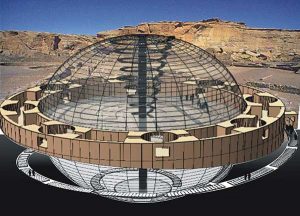
Establish a permanent Labyrinth Light Art Museum in Queens, NYC
I invite you to share my gift to the world: a Labyrinth Light Art Museum in Queens, NYC. On July 13-22, I will stay with friends who will help me find the right location. This project is sponsored by our non-profit organization, Living Labyrinths for Peace, a national organization, whose mission is to inspire healing and transformation within and among people through labyrinth building and education in the schools and the community. The museum will have four rooms:
- “Dance of the Labyrinth” computer programmed photo montage images that light up to your steps.
- Living Labyrinths for Peace Center based on my vision in the Great Kiva of Chaco Nature National Historical Park, NM: There I saw peaceful dancers from many races and cultures ascend an “Under Earth” spiral, to do an “On Earth” Labyrinth Dance on the Kiva floor, and then ascend a spiral “Above Earth” to the skies. Here you are invited to bring your own images (i.e. birthdays, marriages, funeral, model UN workshop), for a light labyrinth design of your choice to walk.
- Educational room with media (power points, videos), my new book of art and poetry: The Labyrinth Path to Light and Peace.
- Wasko Art Gallery: prints on paper and in wall light boxes.
Donations or any contacts in NYC would be so appreciated. Thank you so much. Let us Live Labyrinths for Peace!
Please make checks payable to Living Labyrinths for Peace. Send to:
Sandra Wasko-Flood
P.O. Box 406
Angel Fire, NM 87710
Links
Contact Sandra
WASKO ART
2229 Lake Ave.
Baltimore, MD 21213
Telephone:
(410)243-1189
(703) 217-6706
